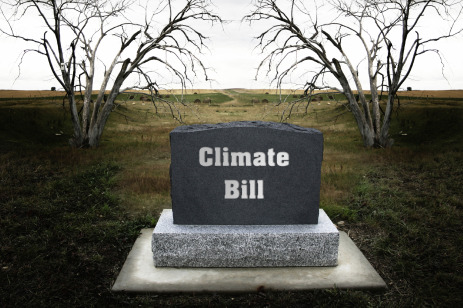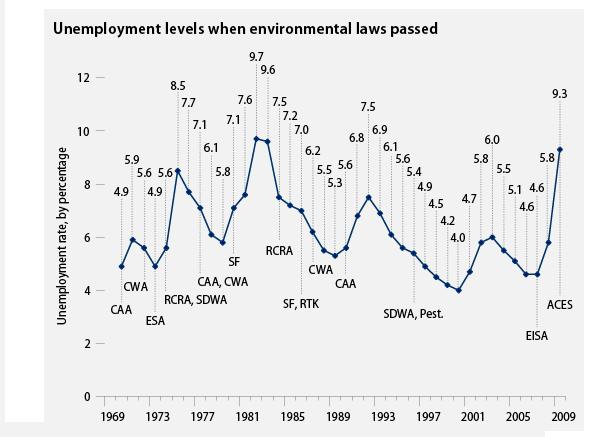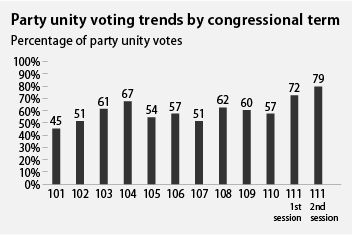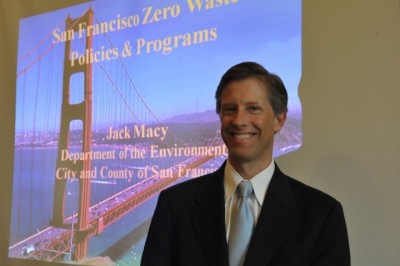 This article was cross-posted from the Center for American Progress.
This article was cross-posted from the Center for American Progress.
President Barack Obama took office with four major domestic agenda items: a plan to prevent the recession from growing worse and launch recovery; health care reform; financial reform to avoid future meltdowns; and clean energy and global warming legislation to create jobs, reduce oil use, and cut pollution. The president succeeded with the first three items. But clean energy legislation died in the Senate after passing the House.
The Oct. 6 New Yorker has a “behind the curtain” dissection of the rise and fall of climate legislation in the Senate. It provides an interesting insider view of the always messy legislative process.
Reporter Ryan Lizza details some senators’ admirable willingness to stretch beyond their comfort zones on some energy issues to cement an agreement that would establish declining limits on carbon dioxide and other global warming pollutants while allowing more offshore oil drilling and subsidies for nuclear power. He also notes the critical miscommunications and different approaches by senators and the Obama administration that reduced prospects for success.
Lizza gives short shrift, however, to the real reasons Senate passage of climate legislation was impossible in 2010: the deep recession, unified and uncompromising opposition in the Senate, and big spending by oil, coal, and other energy interests. Let’s take a close look at these factors.
The Great Recession took its toll
Many economists described this latest recession as the worst since the Great Depression in the 1930s. Economists Alan Blinder and Mark Zandi note in the July 2010 report “How the Great Recession was Brought to an End“:
Eighteen months ago, the global financial system was on the brink of collapse and the U.S. was suffering its worst economic downturn since the 1930s. Real GDP was falling at about a 6% annual rate, and monthly job losses averaged close to 750,000. Today, the financial system is operating much more normally, real GDP is advancing at a nearly 3% pace, and job growth has resumed, albeit at an insufficient pace. [Emphasis mine.]
The economic decline sped up just as Obama took office. Unemployment jumped from 6.2 percent on Labor Day 2008 to 8.2 percent by Obama’s State of the Union on Feb. 24, 2009. Nobel Laureate Paul Krugman noted in March 2009, “At first, the current recession didn’t hit industrial production all that hard. But the pace accelerated dramatically last fall. At this point we’re sort of experiencing half a Great Depression. That’s pretty bad.”
After unemployment peaked at 10.1 percent in October 2009, the jobs picture has not gotten significantly better. The Bureau of Labor Statistics just announced September 2010 unemployment rate held steady at 9.6 percent. AP reported, “The jobless rate has now topped 9.5 percent for 14 straight months, the longest stretch since the 1930s.”
These and other effects of the recession significantly added to many Americans’ long-term economic uncertainty or fear. And this economic environment made politicians much more susceptible to Big Oil, dirty coal, and other special interests’ “tired dance, where folks inside this beltway get paid a lot of money to say things that aren’t true about public health initiatives,” as noted by EPA Administrator Lisa Jackson. This includes skewed studies funded by the oil industry that predicted that global warming pollution reductions would devastate the economy.
The terrible economy and growing unemployment made it much more difficult to pass clean energy and global warming legislation. In fact, an analysis of the unemployment rate when fundamental environmental protection laws were enacted since Earth Day 1970 found that the annual unemployment rate was 6 percent or lower most of the years of enactment. (See chart below.)
This includes all of the major pollution control laws and the Endangered Species Act. These laws established public health safeguards and pollution reduction requirements for industry. This assessment does not include nonregulatory laws such as public lands protection laws. Nor does it include laws that have some pro-environment provisions as part of a broader bill, such as the Energy Policy Act of 2005.

The first Clean Air Act, Clean Water Act, Endangered Species Act, and Resource Conservation and Recovery Act (hazardous waste disposal) were all enacted when unemployment was 6 percent or lower. Unemployment is 50 percent higher now. Only four major environmental laws were enacted with annual unemployment over 7 percent, and none with unemployment greater than 7.5 percent. Unemployment averaged 9.3 percent in 2009 and 9.7 through September 2010.
In other words, the worst unemployment in nearly 30 years made the up-hill climb to pass a global warming bill even steeper. And certainly the special interests’ opposed to action on global warming played on Americans’ concern about unemployment to frighten senators into opposing global warming action.
For instance, the National Petrochemical & Refiners Association urged strong opposition to the American Power Act:
The draconian carbon reduction targets and timetables in this bill would trigger destructive change in America’s economic climate. This would add billions of dollars in energy costs for American families and businesses, destroy the jobs of millions of American workers, and make our nation more dependent on foreign energy sources … If senators want to increase the loss of manufacturing jobs in the United States and postpone the resurgence of the American economy, then they should vote for this bill.
The American Petroleum Institute bought a series of television, radio, and print ads threatening job killing energy taxes. Its homepage headline reads, “More jobs not more taxes.”
The heavily funded U.S. Chamber of Commerce has also poured money into defeating climate and clean energy action for the last several years. More recently, the Big Coal backed Faces of Coal front group staged rallies in protest of EPA’s proposed global warming pollution regulations with signs reading “Coal Keeps the Lights on,” and “Coal Miners ‘Dig’ Their Jobs.”
Whatever it is, we’re against it!
As if high unemployment weren’t enough, Senate advocates of clean energy and global warming pollution reduction legislation had to contend with Senate rules that allow unlimited debate.
This required bill sponsors to persuade a 60-vote “supermajority” to end debate and pass their bill. With several Democrats unalterably opposed to action to reduce global warming, the sponsors needed support from at least four or five Republican senators.
Lizza describes that this was difficult to achieve because opposition to global warming pollution reductions had grown in GOP ranks. What’s more, Senate Minority Leader Mitch McConnell (R-Kan.) convinced his senators that their route to the majority was a solid wall of opposition to whatever Obama wanted to do for the nation.
Lizza reported that:
The Republican Party had grown increasingly hostile to the science of global warming and to cap-and-trade, associating the latter with a tax on energy and more government regulation. Sponsoring the bill wasn’t going to help McCain defeat an opponent to his right.
By not automatically resisting everything connected to Obama, these senators risked angering Mitch McConnell, the Republican leader and architect of the strategy to oppose every part of Obama’s agenda, and the Tea Party movement, which seemed to be gaining power every day.
Sens. John Kerry (D-Mass.), Joe Lieberman (I-Conn.), and Lindsey Graham (R-S.C.) (before he dropped out), the champions of climate legislation, could never break this wall of opposition or neutrality even among Republican senators who had previously sponsored or voted for global warming legislation.
This includes Sen. John McCain (R-Ariz.), who sponsored multiple global warming pollution reduction bills and advocated significant reductions during his 2008 presidential campaign. Sen. Olympia Snowe (R-Maine) also co-sponsored global warming bills in previous Congresses. Nearly four years ago, Sen. Sam Brownback (R-Kan.) said: “It seems to me just prudent that we recognize we have climate increase and temperature change. We have CO2 loading and we need to reduce the amount of CO2 in the atmosphere.”
Yet none of these senators publicly supported action or engaged in serious negotiations with key climate legislation crafters Kerry, Lieberman, or Graham in 2010.
This Republican lockstep opposition to the energy bill and other Democratic priorities is reflected in Senate floor voting patterns. Congressional Quarterly developed a “Party Unity” score based on the proportion of votes that “pitted a majority of one party against a majority of the other.” Such votes reflect that each party’s position was different, and a majority of the senators voted with their party.
The proportion of these party-unity votes have increased significantly over the last 20 years. (See chart below.) In the 101st Congress, serving from 1989-90, less than half the Senate votes were party-unity votes. Before 2009, the highest proportion of Senate party-unity votes occurred in the 104th Congress, from 1995-96. This was the so-called “Contract with America” Congress with the first Republican majority in both houses since 1953.
 Republican leaders in 2009, however, adopted a strategy of opposing Obama on every major legislative effort to deny him victories that would enhance his popularity. Seventy-two percent of Senate votes, therefore, were party unity votes. This grew to 79 percent in 2010, which means nearly four of five votes were along party lines.
Republican leaders in 2009, however, adopted a strategy of opposing Obama on every major legislative effort to deny him victories that would enhance his popularity. Seventy-two percent of Senate votes, therefore, were party unity votes. This grew to 79 percent in 2010, which means nearly four of five votes were along party lines.
The 111th Congress also saw an increase in the proportion of Republican senators voting with their party majority. Eighty-five percent of Republicans voted with their party in 2009, while that increased to 90 percent in 2010. By comparison, there were only three of 10 previous Congresses when Republicans were more unified.
Congressional Quarterly describes the increased Senate polarization in 2010:
Almost four out of five roll call votes in the Senate have pitted a majority of Democrats against a majority of Republicans — the highest percentage of so-called party-unity votes seen since Congressional Quarterly began tabulating them in 1953.
Most telling, however, is the support accorded President Obama on the 51 Senate roll calls this year … where he took a position. On average, Democrats supported him 95 percent of the time, up from 92 percent in 2009. And Republicans backed away from their 50 percent average presidential support score last year to vote with Obama just 42 percent of the time so far this election year.
Sen. Mary Landrieu (D-La.), a conservative Democrat and no ally of global warming legislation, noted that the Senate Republican caucus had become more unified in opposition to Democrats. She said, “This Republican Party’s not the one it used to be. There were moderates that would reach out with those of us that were moderate on the other side, but that’s not the direction they’re going in.”
The best bill money could stop
The House of Representatives passed the American Clean Energy and Security Act on June 26, 2009. This bill was supported by some major companies and trade associations, including the Edison Electric Institute and the Nuclear Energy Institute.
Fear of a consensus energy bill that had some industry support galvanized most big oil and coal companies to invest heavily in their efforts to oppose a Senate bill. Companies in these and other industries thus spent records amounts of money on lobbying, campaign donations, and other pressure tactics to defeat clean energy legislation in the Senate. And this spending does not include millions of dollars spent on message advertising, “astro turf” rallies (fake grass roots), and other pressure tactics that do not require public spending reports.
Opensecrets.org found that electric utilities and oil and gas companies spent more than $500 million in lobbying from January 2009 to June 2010, primarily to weaken or defeat energy legislation. A Center for American Progress Action Fund analysis found that oil companies were six of the top seven spenders on lobbying and campaign contributions during this period, with ExxonMobil number one.
Big Oil’s campaign contributions are heavily tilted toward Republicans, who received 70 percent of the contributions that went to the two parties. Opensecrets.org reports:
[As] debate raged in Congress about offshore drilling, energy independence, ‘cap-and-trade’ legislation and a shift away from fossil-fuel energy sources … congressional candidates and federal political committees nationwide have raked in more than $17 million from the oil and gas industry so far during the 2010 election cycle — a number on pace to easily exceed that of the most recent midterm election four years ago.
The recipients of the funds have remained relatively consistent over the years, with Republicans accumulating a majority of the industry’s campaign contributions.
The coal industry, too, gave nearly 70 percent of its campaign cash to Republicans.
The bigger picture
The New Yorker pulled back the curtain on the admirable but frustratingly unsuccessful efforts of Kerry, Lieberman, Graham, and others to achieve Senate passage of comprehensive clean energy and global warming legislation. But Lizza pinning the blame on the White House or senators misses the larger factors behind this huge disappointment.
Al Gore spelled it out succinctly during an interview with Lizza after the legislation was dead for the year. He agreed that the economy, a unified wall of opposition in the Senate, and special interest spending were at the heart of this outcome:
I asked Al Gore why he thought climate legislation had failed. He cited several reasons, including Republican partisanship, which had prevented moderates from becoming part of the coalition in favor of the bill. The Great Recession made the effort even more difficult, he added. “The forces wedded to the old patterns still have enough influence that they were able to use the fear of the economic downturn as a way of slowing the progress toward this big transition that we have to make.
There were gale force economic, political, and special interest winds blowing against global warming legislation in 2010 that were beyond the influence of its champions. The question should not be “Why did they fail?” but “How did they get so far?”



